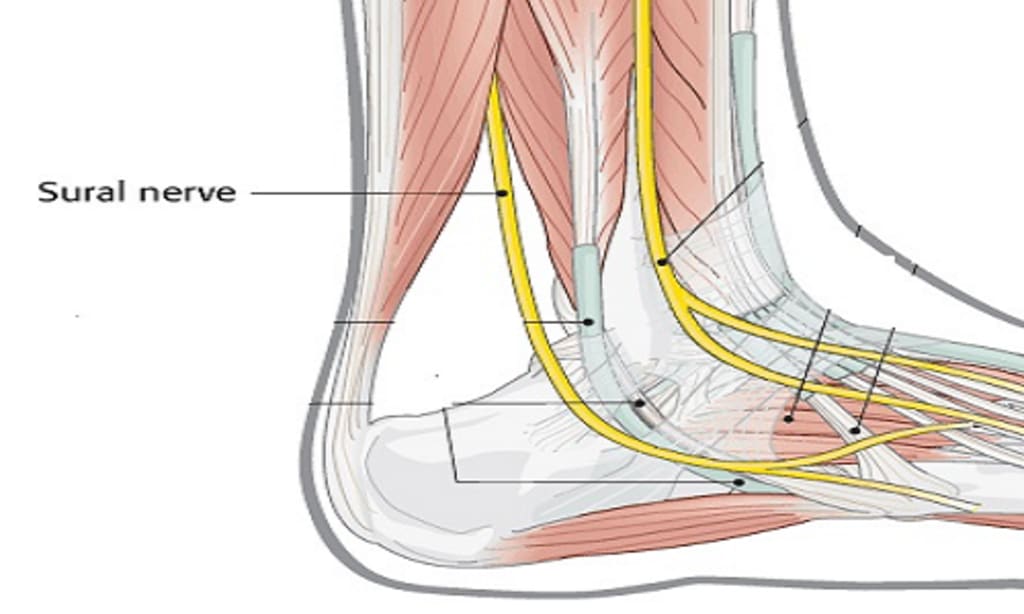what is Pulsed Radiofrequency Ablation for Treating Sural Neuralgia
Ablation for Treating Sural Neuralgia

Sural neuralgia is pain caused by injury or inflammation of the sural nerve. The sural nerve, along with 4 other nerves, provides sensation to the foot. Specifically, the sural nerve provides sensation to the lateral posterior corner of the leg, lateral foot, and fifth toe. The sural nerve is superficial, predisposing it to injuries.1 Common causes of sural neuralgia are direct trauma, external compression, vasculitis, and diabetes. A more concerning cause of sural neuralgia is sural nerve entrapment in which the sural nerve is entrapped by scar tissue that pulls and compresses the nerve, leading to pain. Sural nerve entrapment is a feared postoperative complication of many orthopedic procedures involving the ankle, such as Achilles tendon repair, ankle surgery, fifth metatarsal fracture surgery, and ganglion cyst removal.
Sural neuralgia is a very uncommon illness that frequently responds to non-pharmacological therapies such as gabapentin, calcium channel blockers, tricyclic antidepressants, physical therapy, massage therapy, and anti-inflammatory drugs. Many clinicians have little expertise in managing instances that are resistant to conservative therapy since sural neuralgia is uncommon and frequently amenable to conservative therapy. It is challenging to treat patients with sural neuralgia due to this limited expertise and the lack of information on efficient treatment options. We describe 2 cases of sural neuralgia unresponsive to conservative therapy, where 80 percent pain alleviation was obtained 2 months after pulsed radiofrequency (PRF) ablation.
A 65-year-old woman who had right foot pain and tingling came to our clinic. She rated her pain as being 8 out of 10 on the visual analog scale (VAS), where 0 means there are no pain and 10 means the greatest suffering possible. After having a huge ganglion cyst removed from her right foot and having the third interspace of the transverse metatarsal ligament released, the patient started experiencing pain. The patient had unsuccessfully attempted gabapentin, physical therapy, and nonsteroidal anti-inflammatory medications (NSAIDs). The patient's inability to engage in her typical physical activities, interact with others, or work caused her to develop despair.
The results of the physical examination revealed that the patient had right sural neuralgia, which causes pain and tingling along the nerve's course. The patient experienced significant pain relief following the right sural nerve block, which we carried out to further confirm the diagnosis. To give the patient long-term relief, we chose to move through with PRF ablation. The patient reported an 80% improvement in her pain, a rise in activity level, an increase in social activities and sleep hours, and a noticeable mood change at the 2-month follow-up.
A 33-year-old female was referred to our clinic by her orthopedic surgeon because of a 1-year history of intermittent sharp left foot pain. The maximum severity of her pain was 6/10 on the VAS. Her pain first occurred suddenly while she was walking. Several providers had attempted to determine the underlying cause. The precise etiology was unknown but was thought to be related to previous falls that led to the left knee and ankle trauma. The patient's first fall occurred at work while she was cleaning an ice skating rink, and she fell again a year later while walking in an icy parking lot. Prior to presenting to our clinic, she had tried gabapentin, NSAIDs, a walking boot, orthotic shoe insoles, and physical therapy with limited pain relief.
Her sural neuralgia was discovered during a physical examination. We carried out left sural nerve blocks twice to further corroborate the diagnosis. She reported pain as being 0/10 on the VAS after each of these blocks, however, the pain alleviation only lasted for around 24 hours. In order to give long-term pain relief, we chose to move through with sural nerve PRF ablation. She did well with the procedure and had no issues. She reported an overall pain decrease of 80% at her follow-up session, rating her pain as 1/10.
Procedures
Blocked Sural Nerve
All sural nerve blocks adhered to the aforementioned procedure. There was informed consent received. Chlorhexidine was used to clean the foot of interest, and it was then sterile draped. The Achilles tendon and the lateral malleolus were located in this region. The sural nerve's anatomical placement was the same place, and a 25-g needle was inserted there and pointed toward the lateral malleolus. Negative aspiration was followed by the injection of 2 ccs of 0.25 percent bupivacaine and the removal of the needle. We kept an eye on the patient for issues right after the treatment. After the procedure, the patient provided pain scores and a percentage of improvement.
Pulsed Radiofrequency Ablation
The following protocol was used for all PRF ablations. Informed consent was obtained. Preoperative sedation was provided with midazolam and fentanyl. The patient was placed in the supine position with the foot of interest elevated by a pillow. The foot was cleaned with chlorohexidine and sterile drapes were applied to maintain optimal sterile conditions. The sural nerve was identified between the lateral malleolus and Achilles tendon, and 1% lidocaine was applied to anesthetize the overlying skin. Radiofrequency lesioning needles with active tips of 4 mm (used for Patient 1) or 10 mm (used for Patient 2) were inserted and directed toward the lateral malleolus in the anatomic location of the sural nerve. Sensory testing was performed at 50 Hz to ensure stimulation in the sural nerve distribution. Motor testing at 2 Hz was performed to ensure the absence of motor stimulation. PRF was performed using 40°C of heat (Patient 1) or 60°C of heat (Patient 2) for 180 seconds. Following the ablation, the needles were removed and the patient was monitored for immediate postprocedural complications.
About the Creator
Global News Hubs
i write health, education, motivational, Business, Motivational, Lifestyle and Self confidence, Movies Reviews






Comments
There are no comments for this story
Be the first to respond and start the conversation.